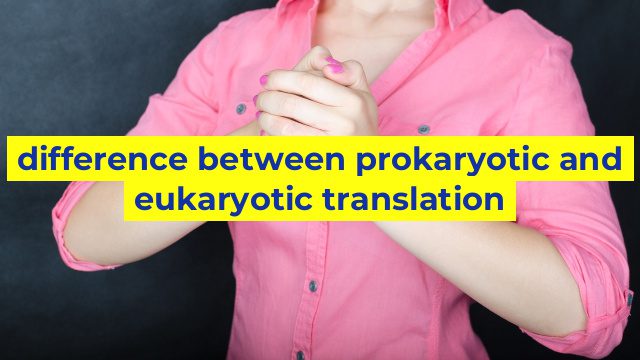Understanding the Differences of Prokaryotic and Eukaryotic Translation
Introduction
Before we delve deeper into the differences between prokaryotic and eukaryotic translation, it’s essential first to define what they are. In simple terms, translation is the process of building a protein molecule. Everything about the process is crucial, from the identification of the correct messenger RNA (mRNA) to the protein’s correct assembly.
What are Prokaryotes and Eukaryotes?
Prokaryotes are single-celled, unicellular organisms with no nucleus. Examples of prokaryotes include bacteria and archaea. On the other hand, eukaryotes are multicellular organisms with a nucleus and various membrane-bound cell organelles that accommodate metabolic reactions. Examples of eukaryotes include animals, plants, and fungi.
What is Translation Process?
Both prokaryotic and eukaryotic translation begins when the ribosome binds to an mRNA molecule. The translation process starts once the ribosome reaches the initiation codon (AUG), and initiation factors recruit the tRNA carrying methionine to the ribosome.
Differences Between Prokaryotic and Eukaryotic Translation Process
While there are similarities between prokaryotic and eukaryotic translation, some differences set them apart. They include the following:
1. Ribosomes – Prokaryotes use 70S ribosomes, with a small subunit made up of 16S ribosomal RNA (rRNA) and a large subunit made up of 23S rRNA and 5S rRNA. Eukaryotes use 80S ribosomes, with a small subunit made up of 18S rRNA and a large subunit made up of 28S, 5.8S, and 5S rRNA.
2. mRNA – Prokaryotes have polycistronic mRNA with several genes transcribed together, and eukaryotes have monocistronic mRNA, just one gene is transcribed.
3. Initiation – Prokaryotes use Shine-Dalgarno sequences on mRNA to position the ribosome correctly. Eukaryotes use a 5′ cap and a cap-binding protein.
4. Elongation – Prokaryotes have fewer elongation factors than eukaryotes.
5. Termination – Prokaryotes have a polypeptide release factor, RF1 or RF2, to terminate translation. Eukaryotes have eRF1 to terminate translation.
Conclusion
In conclusion, while there are similarities between prokaryotic and eukaryotic translation, the differences are significant. The use of different ribosomes, mRNA, initiation, elongation, and termination stages makes for unique translation processes. Understanding these differences is essential for developing therapies that specifically target cells with a dysfunctional translation process.
Table difference between prokaryotic and eukaryotic translation
| Property | Prokaryotic Translation | Eukaryotic Translation |
|---|---|---|
| Translation Site | Cytoplasm | Cytoplasm and Rough Endoplasmic Reticulum |
| Ribosomes | 70S ribosomes (consist of 50S and 30S subunits) | 80S ribosomes (consist of 60S and 40S subunits) |
| mRNA | Polycistronic mRNA (multiple genes are transcribed as a single mRNA) | Monocistronic mRNA (one gene is transcribed as a single mRNA) |
| Initiation Factors | Three initiation factors are required (IF1, IF2, and IF3) | Several initiation factors are required (eIF1, eIF2, eIF3, and eIF4F) |
| Start Codon Recognition | Formylmethionine (fMet) is used as a start codon | Methionine (Met) is used as a start codon |
| Post-Translational Modifications | Little or no post-translational modifications | Extensive post-translational modifications (e.g. glycosylation, phosphorylation, acetylation, etc.) |

